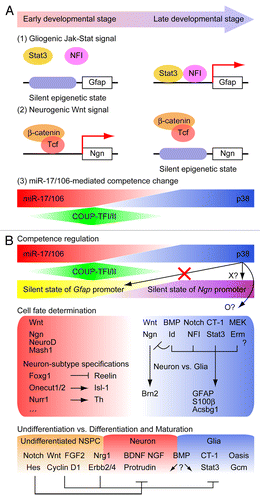Figures & data
Figure 1. (A) Molecular mechanisms underlying the regulation of the neurogenic-to-gliogenic transition of developing NSPCs by epigenetic modulation and miR-17/106. (1) Epigenetic silencing of the STAT3 binding sites in the promoters of glial genes such as Gfap prevents the response to the activated JAK-STAT signaling pathway in early developmental NSPCs. (2) Epigenetic modification of the proneural Ngn gene in late developmental NSPCs prevents binding of the Wnt signal-induced β-catenin/Tcf transcriptional complex. (3) High expression levels of miR-17/106 in early developmental NSPCs prevents activation of the p38 MAPK pathway and the initiation of neurogenic-to-gliogenic competence transition. (B) An overview of the multi-layered regulatory systems and molecular mediators involved in the neurogenic-to-gliogenic transition of NSPCs. In early developmental stages, miR-17/106 represses p38 expression and prevents the initiation of competence transition. Sequential expression of a number of transcription factors, including Foxg1, Onecut1/2, Nurr1, and multiple other proteins, regulates neuron-subtype specifications. Expression of Coup-tfI/II triggers the neurogenic-to-gliogenic competence transition of NSPCs. In late developmental NSPCs, upregulation of p38 caused by a decline in miR-17/106 expression and changes in the epigenetic statuses of proneural and astrocytic genes induce changes in the responsiveness to extrinsic signals, and BMP, Notch, JAK-STAT, and MEK signals promote gliogenesis. Regulators of the timing of differentiation and subsequent maturation also coordinate the neurogenic-to-gliogenic transition of NSPCs.

